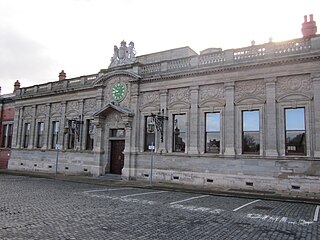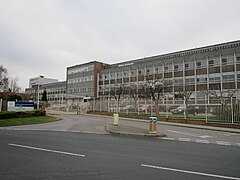
Lever Brothers was a British manufacturing company founded in 1885 by two brothers: William Hesketh Lever, 1st Viscount Leverhulme (1851–1925), and James Darcy Lever (1854–1916). They invested in and successfully promoted a new soap-making process invented by chemist William Hough Watson. Lever Brothers entered the United States market in 1895 and acquired Mac Fisheries, owner of T. Wall & Sons, in 1925. Lever Brothers was one of several British companies that took an interest in the welfare of its British employees. Its brands included "Lifebuoy", "Lux" and "Vim". Lever Brothers merged with Margarine Unie to form Unilever in 1929.

The Metropolitan Borough of Wirral is a metropolitan borough of Merseyside, in North West England. It has a population of 321,238, and encompasses 60 square miles (160 km2) of the northern part of the Wirral Peninsula. Major settlements include Birkenhead, Wallasey, Bebington, Heswall, Hoylake and West Kirby. The city of Liverpool faces the northeastern side of Wirral over the Mersey.

Bebington is a town in the Metropolitan Borough of Wirral, in Merseyside, England. Historically part of Cheshire, it is 5 miles (8 km) south of Liverpool, close to the River Mersey on the eastern side of the Wirral Peninsula. Nearby towns include Birkenhead and Wallasey to the north-northwest, and Heswall to the west-southwest. Bebington railway station opened in 1838 and is on the Wirral line of the Merseyrail network.

Port Sunlight is a model village in the Metropolitan Borough of Wirral, Merseyside, England. It is located between Lower Bebington and New Ferry, on the Wirral Peninsula. Port Sunlight was built by Lever Brothers to accommodate workers in its soap factory ; work commenced in 1888. The name is derived from Lever Brothers' most popular brand of cleaning agent, Sunlight.

Bromborough is a town in the Metropolitan Borough of Wirral, Merseyside, England, and the historic county of Cheshire, on the Wirral Peninsula southeast of Bebington and north of Eastham.

New Ferry is an urban area on the Metropolitan Borough of Wirral, Merseyside, England. It is located on the Wirral Peninsula, with the River Mersey to the east and the town of Bebington to the west. Within the boundaries of the historic county of Cheshire, the area was developed from the early nineteenth century.

The Wirral Peninsula, known locally as The Wirral, is a peninsula in North West England. The roughly rectangular peninsula is about 15 miles (24 km) long and 7 miles (11 km) wide, and is bounded by the Dee Estuary to the west, the Mersey Estuary to the east, and Liverpool Bay to the north.

Thornton Hough is a village and former civil parish in the Wirral district of Merseyside, England. The village lies in the more rural inland part of the Wirral Peninsula and is of pre-Norman Conquest origins. The village grew during the ownership of Joseph Hirst into a small model village and was later acquired by William Lever, founder of Lever Brothers, the predecessor of Unilever. Thornton Hough is roughly 10 miles (16 km) from Liverpool and 12 miles (19 km) from Chester. It is part of the Clatterbridge ward and is in the parliamentary constituency of Wirral South.

Storeton is a small village and former civil parish in the Wirral district, in the county of Merseyside, England, on the Wirral Peninsula. It is west of the town of Bebington and is made up of Great Storeton and Little Storeton, which is classified as a hamlet. At the 2001 Census the population of Storeton was recorded as 150.
Wellington School was a small private grammar school in Wellington Road, Bebington, Metropolitan Borough of Wirral, England.

Wirral Grammar School for Boys was founded in 1931 as a maintained selective grammar school for boys aged 11–18. It is situated on a 9.1 acres (3.7 ha) site to the west of Port Sunlight at Cross Lane, Bebington, on the Wirral Peninsula in England. Academically successful, the school was placed 42nd in the top 100 in the Daily Telegraph A-Level table in 2015 and 145th in the DfE GCSE table in the same year, but has not been inspected since its conversion to academy status.

Clatterbridge Hospital is a general hospital located on Clatterbridge Health Park in Bebington, Wirral, England. It is managed by Wirral University Teaching Hospital NHS Foundation Trust.

The Clatterbridge Cancer Centre is an NHS Foundation Trust, which specialises in the treatment of cancer. The centre is one of several specialist hospitals located within Merseyside; alongside Liverpool Heart and Chest Hospital, Alder Hey Children's Hospital, Liverpool Women's Hospital, and the Walton Centre.

Hulme Hall in Port Sunlight, on the Wirral Peninsula in Merseyside, England, is a Grade II listed building, first registered as such in 1965.
Unilever Leeds, in the north-east of Leeds off the A6120 Leeds Outer Ring Road, is a large cosmetics factory and research site of the Anglo-Dutch company Unilever that makes all of its deodorant products for the UK. It is the largest deodorants factory in Europe. The factory supplies the whole of Europe.
The history of air traffic control in the United Kingdom began in the late 1950s, and early 1960s, when an integrated and coordinated system began, once radar had become sufficiently advanced to allow this.

Unilever Gloucester is a large food manufacturing site in the north-east of Gloucester, England, that produces all of the makes of Unilever ice cream for the UK.
The Shell Technology Centre was a chemical and oil products research institute in northern Cheshire, near Stanlow, owned by Anglo-Dutch Shell.

Chesterford Park Research Station was a former crop protection research centre in Essex, and is now a science park with biotechnology companies.
The Unilever Research Laboratorium was a nutrition and human biology research centre in South Holland, owned by Unilever, and since November 2019, has been a private science park.



















